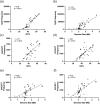Role of immunostimulatory deoxycytidylate-phosphate-deoxyguanylate (CpG) motifs in oral bacteria associated with oral diseases
- PMID: 40213770
- PMCID: PMC11983586
- DOI: 10.1080/20002297.2025.2486639
Role of immunostimulatory deoxycytidylate-phosphate-deoxyguanylate (CpG) motifs in oral bacteria associated with oral diseases
Abstract
Background: CpG oligodeoxynucleotide motifs in bacterial DNA with composition variations exhibit potent immunostimulation. The effect of different compositions in oral infections is unclear. This study aims to investigate CpG motifs in bacteria associated with endodontic diseases, periodontal diseases, and dental caries to elucidate their influence on host immune response.
Methods: Fifty oral bacterial genomes were selected for in silico analysis to determine GC% content and CpG motif frequency in each genome. The relationships between GC% content, CpG motif frequency, and genome size were assessed using correlation analysis. Normalisation of immunostimulatory sequences was implemented to enable unbiased comparison of frequency counts among bacteria.
Results: Sixty percent of bacteria exhibited medium GC% content (Mdn = 44), with no significant difference among bacteria associated with these diseases (p = 0.66). A positive correlation between GC% content and CpG motif frequency, as well as genome size and CpG motifs frequency was observed. A higher-than-mean of the human immunostimulatory motif (GTCGTT, 7/14) and the mice/rabbits immunostimulatory motif (GACGTT, 9/14) was observed in core endodontic microbiota.
Conclusion: CpG motifs in oral bacteria might drive disease progression through host immunomodulation. Variation in bacterial CpG motifs suggests targeting these motifs offers a promising therapeutic intervention.
Keywords: CpG; caries; endodontic diseases; genome; immunostimulatory; oral bacteria; periodontal diseases.
© 2025 The Author(s). Published by Informa UK Limited, trading as Taylor & Francis Group.
Conflict of interest statement
No potential conflict of interest was reported by the author(s).
Figures



Similar articles
-
Immunostimulatory CpG motifs in the genomes of gut bacteria and their role in human health and disease.J Med Microbiol. 2014 Feb;63(Pt 2):293-308. doi: 10.1099/jmm.0.064220-0. Epub 2013 Nov 19. J Med Microbiol. 2014. PMID: 24255136
-
Characterization of immunostimulatory CpG-rich sequences from different Bifidobacterium species.Appl Environ Microbiol. 2010 May;76(9):2846-55. doi: 10.1128/AEM.01714-09. Epub 2010 Mar 5. Appl Environ Microbiol. 2010. PMID: 20208019 Free PMC article.
-
Human TLR9 confers responsiveness to bacterial DNA via species-specific CpG motif recognition.Proc Natl Acad Sci U S A. 2001 Jul 31;98(16):9237-42. doi: 10.1073/pnas.161293498. Epub 2001 Jul 24. Proc Natl Acad Sci U S A. 2001. PMID: 11470918 Free PMC article.
-
Biological activity of immunostimulatory CpG DNA motifs in domestic animals.Vet Immunol Immunopathol. 2003 Jan 30;91(2):89-103. doi: 10.1016/s0165-2427(02)00246-5. Vet Immunol Immunopathol. 2003. PMID: 12543546 Review.
-
Modulation of Toll-like Receptor 9 Responses through Synthetic Immunostimulatory Motifs of DNA.Ann N Y Acad Sci. 2003 Dec;1002:30-42. doi: 10.1196/annals.1281.005. Ann N Y Acad Sci. 2003. PMID: 14751820 Review.
References
LinkOut - more resources
Full Text Sources
Miscellaneous
